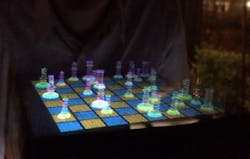Voxiebox 3D hologram viewable without special glasses or headsets
Co-inventors Will Tamblyn and Gavin Smith have created a swept-surface volumetric display—a hologram that floats in the darkness. Their company, VOXON, reaches from South Australia to Silicon Valley and their swept-surface 3D volumetric display called Voxiebox is viewable from all sides without any glasses, headsets, or other equipment.
RELATED ARTICLE: 3D digital holograms visualize biomedical applications
The co-inventors say Voxiebox has potential in advertising, education, design, gaming, entertainment, medical applications and more.
While Smith and Tamblyn developed a working prototype out of a shed—they came across a YouTube video almost three years ago of nearly identical holographic display technology in the United States; the demo was of a woolly mammoth rather than their dinosaur.
They rushed out a crowd funding campaign in an attempt to beat the American team to the punch, but their prototype wasn't mature enough and funding failed. The campaign had an unexpected consequence though: the US team noticed their efforts and proposed a merger.
They took on the existing company name, VOXON, and merged their prototypes in to the Voxiebox. The team is split between Adelaide, where Smith and Tamblyn work out of the Tonsley advanced manufacturing precinct, San Francisco, where their CEO Sandira Calviac is based, New York, and Rhode Island.
Each member of the team is multi-disciplined. Most members wear multiple hats, from business development to engineering and manufacture design. Ken Silverman is a recent addition, famous for his work in programming the Build graphics engine that powers classic games like Duke Nukem 3D and Shadow Warrior use.
"The immediacy of the device is one of the key driving points. You can plonk it on a table in a meeting, or a school or an airport. People gather around it. You get a shared social experience, like playing a board game or the old table top arcade games in bars," Smith says. VOXON's device currently has a resolution of around 1000 on the X plane, 1000 on the Y plane and 200 on the vertical Z plane. It isn't measured in pixels, but voxels—volumetric pixels, essentially cubes of light.
Voxiebox works by rapidly moving a flat screen up and down. An extremely fast projector projects 'slices' of light onto the screen as it moves. When it's moving fast, the screen blurs itself in to nothing and a fully animated volume of light remains, made up of the slices of light.
"If you want smooth motion for gaming or video, you need 60 frames per second (fps). That's for a screen that's not moving. For each layer of vertical light (the 200 voxel tall Z plane) you need to project 60 fps. The more resolution you have on the Z plane, the more detailed objects you can display. So the faster we can make the project refresh rates, the more slices of vertical resolution we can have."
Where a regular projector can manage 60 fps with 16 million colors, VOXON's projector works at thousands of frames per second with only a few colors. They are experimenting with using multiple projectors to make up for the color shortcoming.
"Games from the 80s can be written for the Voxiebox by a single person in a couple of days. There are thousands of those. The size suits itself to things like soccer too—a long, wide field with players that are maybe five centimetres tall."
They've taken the Voxiebox to schools, explaining difficult concepts like four dimensional hypercubes. NASA has used it to project 3D models of asteroids. There's potential to display 3D medical data—scans of organs and bones, and even block out light to create slices of data like an MRI.
VOXON is currently searching for venture capital funding to develop a commercial product. They recently received a $50,000 Venture Catalyst grant from the University of South Australia and the South Australian government. Prototypes are currently in the hands of early adopters to get feedback on the device and its capabilities.
"The whole sci-fi angle is good for us. It's the future you've imagined. It's the type of display that crops up in movies like Avatar, Minority Report and Star Wars. And, you know, what we're doing here, it's just the tip of the iceberg on what's possible."
SOURCE: The Lead; http://theleadsouthaustralia.com.au/industries/technology/holographic-visions-of-the-future-from-an-australian-shed/

Gail Overton | Senior Editor (2004-2020)
Gail has more than 30 years of engineering, marketing, product management, and editorial experience in the photonics and optical communications industry. Before joining the staff at Laser Focus World in 2004, she held many product management and product marketing roles in the fiber-optics industry, most notably at Hughes (El Segundo, CA), GTE Labs (Waltham, MA), Corning (Corning, NY), Photon Kinetics (Beaverton, OR), and Newport Corporation (Irvine, CA). During her marketing career, Gail published articles in WDM Solutions and Sensors magazine and traveled internationally to conduct product and sales training. Gail received her BS degree in physics, with an emphasis in optics, from San Diego State University in San Diego, CA in May 1986.
